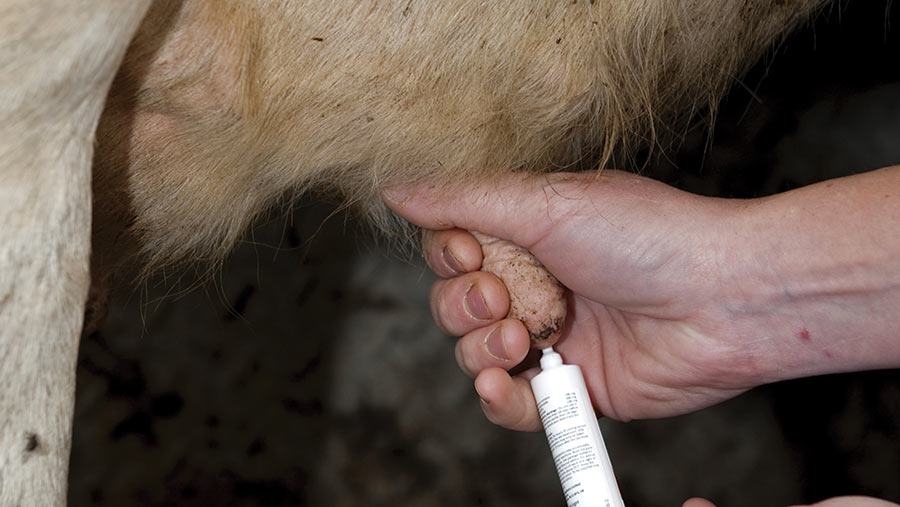8 essential jobs when drying off cows
 ©FLPA/Rex Shutterstock
©FLPA/Rex Shutterstock For some farmers the dry period is a welcome bit of down-time before the onset of calving.
But for the cows it is an important time for udder tissue to replenish and develop ready for lactation.
And there are a number of jobs that can be done to ensure a cow is in the best of health for the year ahead.
Sarah Caldwell, from Calweton Veterinary Group, Cornwall, identifies eight key areas for attention at drying off.
1 – Body condition scoring (BCS)
Cows should ideally enter the dry period with a BCS of 2.75-3 to prevent calving difficulties, milk fever and fatty liver.
BCS should be monitored throughout the dry period and should not alter by more than 0.25 during this time, advises Miss Caldwell.
“In order to maintain the BCS the diet provided should be the best available – highly palatable and provided in a way that will maximise dry matter intake (DMI),” she adds.
2 – Foot trimming
Lameness can further reduce feed intakes and future yields and fertility, so she suggests using a professional or fully trained foot trimmer to get on top of lameness.
She says feet should not be trimmed at the same time as infusing dry cow tubes, due to the increased risk of mastitis from muck contamination. Timing is also key. “Avoid trimming any closer to calving as the stress can induce labour,” adds Miss Caldwell.
3 – Selective dry cow therapy
Dry cow therapy needs to be applied on a case-by-case basis, as milk buyers now have tighter stipulations on application. Teat sealants, used alone, can prevent udder infections during the dry period, however a stringent selection process must be used to ensure only appropriate cows are selected.
These should be applied after the last milking with special attention paid to hygiene. “Wearing gloves, use disinfectant wipes to clean teats, starting at the back teat and working forward, and then infuse the product from the front teats backwards to avoid contamination,” says Miss Caldwell.
The same method applies for antibiotic application. Remove sealants after calving so the calf can get access to colostrum.
See also: Dry cow therapy academy
4 – Assess diet, nutrition and feed management
Dry cows need easy access to the best-quality feed to maintain body condition and provide the correct balance of minerals and trace elements.
DMI should be 1.9-2.1% of body weight between eight and three weeks before calving and in the last three weeks at 1.6-1.8% of body weight, says Miss Caldwell.
“The ration needs to be quite fibrous to maintain rumen fill, as well as being palatable. Straw can be a good buffer, but it needs to be cut at around two to three inches in length to avoid sorting.”
She warns grazing cows are at higher risk of milk fever due to high potassium and low magnesium levels, so she advises farmers to supplement magnesium to combat this.
5 – Parasite control
Some wormers and flukicides have long withdrawal periods for milk, meaning the dry period can offer an ideal opportunity to identify and treat parasites.
“If animals have come into contact with worms, the greatest impact will be post-calving due to the natural immuno-suppressed status the cow will experience during this period,” says Miss Caldwell.
To reduce the risk of anthelmintic resistance, avoid combination products when not required; rotate active ingredients and ensure equipment is calibrated properly.
6 – Immune system and vaccination
Immune system function is closely related to stress, so minimise cow movements during the dry period and consider vaccinating cows during this time.
“The main benefit of vaccinating a cow during the dry period is passing on increased antibody responses to the calf,” says Miss Caldwell. Common vaccines include those for Bovine Viral Diarrhoea, Infectious Bovine Rhinotracheitis, Salmonella and Rotavirus.
7 – Housing
Cow comfort is highly important, so cows should always have sufficient lying space inside and outside, and building ventilation should be assessed.
“Cows have a thermal neutral zone of 5C to 20C so make sure provisions are in place if the temperature exceeds 22C,” says Miss Caldwell. Install a thermometer in the shed and use fans to move stagnant air.
Cows should be lying and ruminating for a large part of the day. “Assess hygiene and make sure bedding is clean. This is paramount as cows are at greater risk of getting a uterine infection as the cervix dilates.”
8 – Monitoring for transition diseases
Urine tests to monitor pH levels can be useful to assess the risk of milk fever in transition cows and allow necessary diet changes.
Blood samples to check for excess fat mobilisation will also flag up any energy deficiency which will predispose the cow to ketosis and left displaced abomasum after calving, says Miss Caldwell.
It’s also worth monitoring iodine and selenium levels due to their impact on retained cleansings, calf vitality and subsequent fertility.
